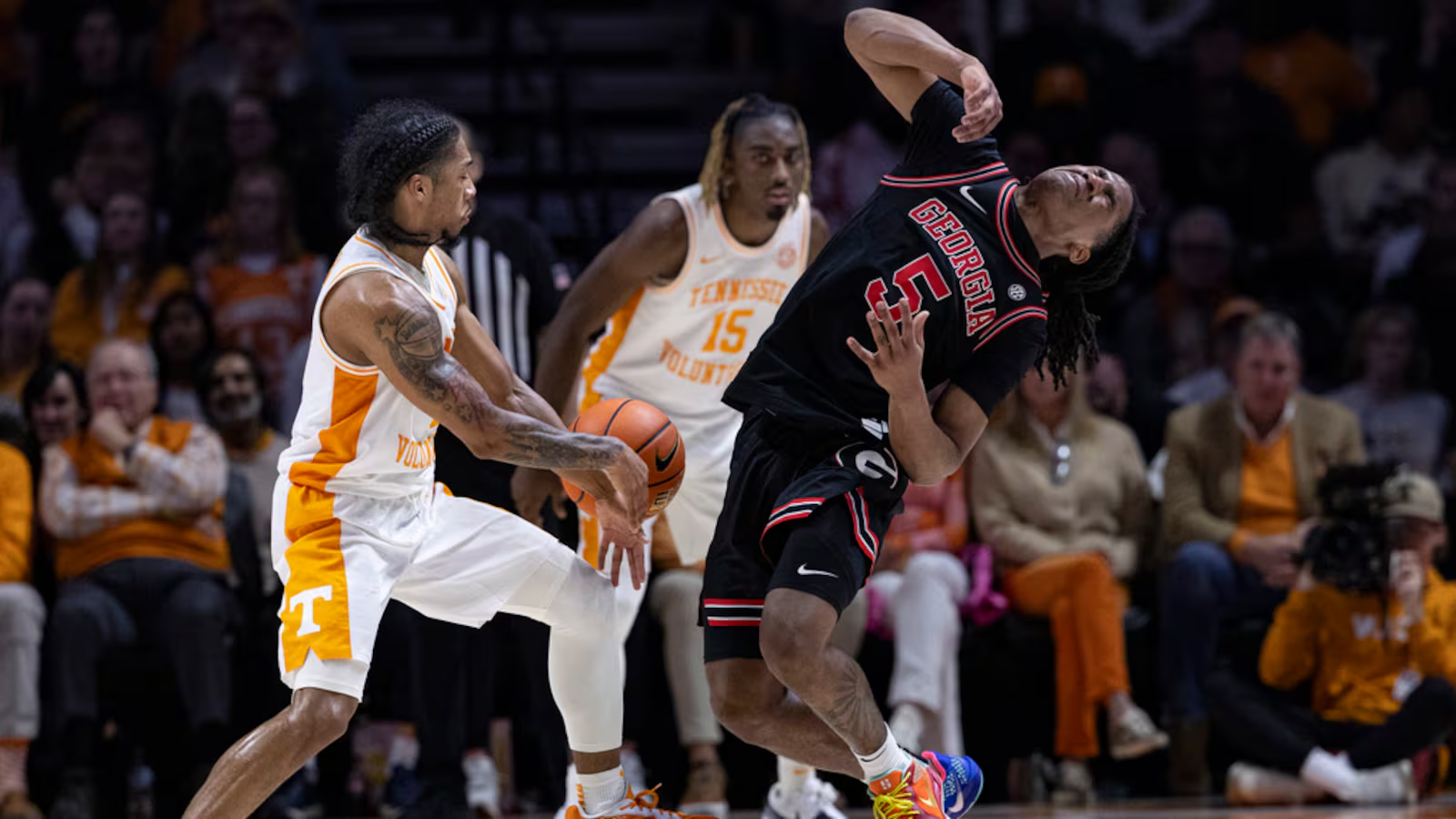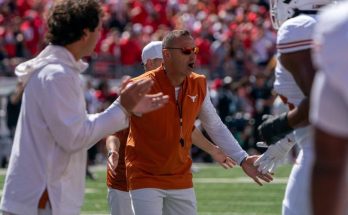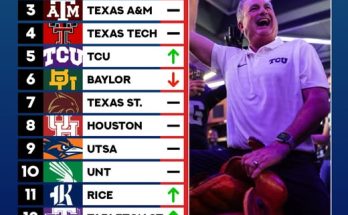Georgia Basketball Loses to No. 6 Tennessee on the Road After a Second-Half Meltdown
The Georgia Bulldogs entered their highly anticipated road matchup with the No. 6-ranked Tennessee Volunteers with high hopes and a firm belief that they could pull off an upset. The game, held at Thompson-Boling Arena in Knoxville, Tennessee, promised to be a tough challenge, but Georgia was riding a wave of confidence after a solid start to the season. However, what initially seemed like a competitive and well-played contest soon turned into a nightmare for the Bulldogs, as they experienced a second-half meltdown that resulted in a disappointing loss.
In this article, we’ll break down the game’s key moments, explore the factors behind Georgia’s second-half collapse, and reflect on what this loss means for the Bulldogs moving forward in their SEC campaign.
First-Half Promise: Georgia’s Strong Start
Georgia opened the game with impressive energy and focus, looking to set the tone early in one of the most hostile environments in the SEC. The Bulldogs’ defense was tenacious, and they showed an ability to execute offensively in a way that kept them competitive with one of the nation’s best teams.
Led by the steady play of Kario Oquendo and Terry Roberts, Georgia’s offense clicked early on. Oquendo, a dynamic guard with the ability to create his own shot, was instrumental in keeping the Bulldogs in the game. He scored consistently, using his quickness and athleticism to exploit Tennessee’s defense. Meanwhile, Roberts provided veteran leadership, orchestrating the offense with poise and contributing with his scoring ability as well.
Georgia’s defense was just as solid, containing Tennessee’s perimeter shooting and forcing the Volunteers into tough, contested shots. The Bulldogs used their athleticism to disrupt Tennessee’s offensive rhythm, particularly by limiting the effectiveness of their high-scoring guards such as Santiago Vescovi and Josiah-Jordan James.
For much of the first half, Georgia was able to match Tennessee’s intensity, and it was clear that the Bulldogs were not intimidated by their higher-ranked opponents. They fought tooth and nail for every point and stayed within striking distance. By the time the first half ended, Georgia trailed by just 4 points, 34-30, which left them with a real shot at an upset.
A Tale of Two Halves: The Meltdown
The second half, however, proved to be a different story altogether.
Tennessee Head Coach Rick Barnes, known for his ability to adjust and adapt, made key tactical changes that turned the game in his team’s favor. Georgia, on the other hand, appeared to lose its composure as the Volunteers gradually gained control. The Bulldogs’ offense, which had been effective in the first half, seemed to stall. Several key players, including Oquendo and Roberts, were held in check, and the team struggled to find its rhythm on the offensive end.
Tennessee began to assert itself physically, dominating the glass and forcing turnovers that led to easy fast-break points. The Volunteers’ full-court pressure defense disrupted Georgia’s flow, and the Bulldogs became more prone to making mistakes as the game wore on.
One of the most glaring issues for Georgia was their inability to keep pace with Tennessee’s pace. The Volunteers began to push the ball up the court more aggressively, exploiting the Bulldogs’ lack of transition defense. As a result, Tennessee was able to create open looks and score with more frequency. The Volunteers went on a series of runs, with Zakai Zeigler and Vescovi becoming more involved in the offense, hitting three-pointers and creating scoring opportunities for their teammates.
Georgia’s defense, which had been solid in the first half, began to falter as Tennessee’s pressure and offensive execution started to wear them down. The Bulldogs allowed open shots on the perimeter and were slow to rotate defensively, leading to easy baskets for the Volunteers.
At the same time, Georgia’s offense completely stagnated. What had been fluid and effective in the first half turned into a series of missed shots, forced plays, and poor decision-making. In particular, the Bulldogs’ inability to finish at the rim became evident. Several missed layups and free-throw attempts seemed to sap their confidence, and Tennessee capitalized with fast-break points that widened the gap.
By the midway point of the second half, Tennessee had extended their lead to double digits, and Georgia’s chances of pulling off an upset appeared slim. The Bulldogs’ resolve began to wane, and they were unable to find the necessary adjustments to stem the tide. Tennessee had taken full control of the game, and Georgia’s second-half meltdown was complete.
The Volunteers finished the game with a dominant 77-58 victory, outscoring Georgia 43-28 in the second half.
Key Moments in the Second-Half Collapse
Several key moments contributed to Georgia’s second-half collapse:
- Turnovers and Poor Decision-Making: After committing just 7 turnovers in the first half, Georgia struggled to take care of the ball in the second half, committing 11 turnovers. These turnovers led to easy points for Tennessee, which fed off the Bulldogs’ mistakes. As the game progressed, Georgia became more frantic in their attempts to generate offense, leading to rushed shots and errant passes.
- Rebounding Woes: Tennessee dominated the boards in the second half, out-rebounding Georgia 24-14. The Bulldogs were consistently beaten to loose balls and had difficulty securing defensive rebounds, giving the Volunteers second-chance opportunities. This disparity in rebounding was a critical factor in Tennessee’s ability to extend their lead.
- Tennessee’s Bench Contributions: While Georgia’s starters struggled in the second half, Tennessee’s bench stepped up in a big way. Julian Phillips and Tyreke Key provided significant contributions off the bench, adding scoring and energy that helped keep the momentum firmly with the Volunteers. Phillips, in particular, provided a spark with his athleticism and scoring ability.
- The Impact of Zakai Zeigler and Santiago Vescovi: While Tennessee’s entire roster played well, the efforts of Zeigler and Vescovi in the second half were especially noteworthy. Zeigler’s quickness and ability to disrupt Georgia’s offense were evident as he applied pressure throughout the game. Vescovi’s sharp shooting, including several key three-pointers in the second half, helped to create separation between the two teams.
- Inability to Finish: Georgia’s inability to finish at the rim in the second half was a significant issue. Time and again, the Bulldogs found themselves in position to score but missed layups and short-range shots. These missed opportunities not only wasted valuable possessions but also took the wind out of Georgia’s sails.
What Went Wrong for Georgia?
In retrospect, Georgia’s second-half collapse can be attributed to a combination of factors that ultimately resulted in the Bulldogs losing their edge.
First and foremost, the Bulldogs failed to adapt to Tennessee’s adjustments. Tennessee ramped up the pressure on both ends of the floor, and Georgia was unable to respond effectively. The Bulldogs struggled to execute their offense under the Volunteers’ defensive intensity, and they failed to capitalize on key opportunities.
Additionally, Georgia’s mental composure was tested, and they ultimately lost focus in critical moments. As Tennessee surged, the Bulldogs seemed to lose confidence, leading to a series of mistakes on both ends of the floor. Whether it was turning the ball over or missing easy shots, Georgia’s players became visibly frustrated as the game slipped away.
Finally, Tennessee’s depth and experience shone through in the second half. The Volunteers had multiple players who could step up and make plays when needed. On the other hand, Georgia’s lack of depth and the reliance on a smaller core of players ultimately hurt their chances of mounting a comeback.
Looking Ahead: What’s Next for Georgia?
This loss to Tennessee is certainly a setback for Georgia, but it also provides valuable lessons as they continue to progress through the SEC schedule. The Bulldogs will need to work on maintaining their composure throughout the full 40 minutes of a game, especially against elite teams like Tennessee. They also need to focus on improving their ball security and rebounding, as both were areas of struggle in the second half.
Moving forward, head coach Mike White will need to address the mental aspects of his team’s play, ensuring that his players stay focused and composed when the game gets tough. Georgia has the talent to compete with the best teams in the conference, but they must learn how to execute in high-pressure situations if they want to contend for a spot in the NCAA Tournament.
The Bulldogs still have a strong foundation in place, with players like Oquendo, Roberts, and Braelen Bridges providing leadership and skill. But they must grow as a team and avoid the kind of second-half meltdowns that cost them games like this one.
As Georgia prepares for the rest of the SEC schedule, they’ll need to take the lessons from this loss and build upon them. If they can find consistency and learn how to close out games against top competition, the Bulldogs could still make noise in the conference and make a run at an NCAA Tournament berth. But that will require resilience, adjustment, and the mental fortitude to bounce back after tough defeats. The road ahead is challenging, but it’s not insurmountable for a team with the talent and potential that Georgia possesses.



